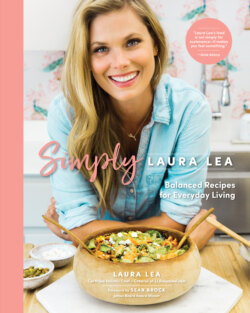Читать книгу Simply Laura Lea - Laura Lea - Страница 24
На сайте Литреса книга снята с продажи.
Оглавлениеvaries from company to company, but it is still a
better choice than conventional. If you’re not sure
about the quality of the dairy you’re purchasing, I
suggest reaching out directly to the company offering
the product.
As you can see, there is a generous amount of
research that supports including high-quality dairy
in one’s daily food routine. In this cookbook, I use
cheese, butter, and sour cream, which are fermented,
probiotic rich forms of dairy that can be easier to
digest than milk. Many adults are lactose-intolerant
and have Primary Lactase Deficiency, in which case
the production of lactase, the enzyme responsible
for the digestion of lactose, declines over time. This
typically begins around age two, but symptoms may
not appear until later in childhood or even early
adulthood. However, some pepople do fine with
cow’s milk on a regular basis. Note that I offer a non-
dairy substitution in most recipes, but not all. That
said, the majority of my recipes are still dairy-free.
Soy and Tofu
I didn’t include a single tofu recipe in my first
cookbook, for two primary reasons: 1) I didn’t enjoy
eating it, and 2) I had the option of including tempeh
as a soy-based source of protein. Tempeh is always
fermented, which can make it easier to digest. While I
still absolutely adore tempeh, I have also fallen in love
with tofu. I don’t remember when I began my tofu
affair, but I do remember immediately running out
to buy more and start experimenting. I also began to
dive into the controversial research about tofu.
Much of the conflict surrounding soy, and
particularly tofu, centers on its high concentration
of isoflavones. Isoflavones act as phytoestrogens,
or plant-derived estrogen, in mammals. As a result,
when we eat sources of isoflavones, such as soy, our
bodies may respond as if human endocrine system
estrogen were present. This has led certain studies
to conclude that consuming soy may negatively
impact hormone-driven illness, particularly
estrogen-dominant breast cancer. On the flip side,
a Japanese study found that the consumption of
soybeans may reduce the risk of breast cancer.
What’s the deal? Well, it all depends on context.
Factors such as age, hormone levels, ethnicity, the
type of soy, and countless qualifiers about the studies
themselves can all impact an ultimate conclusion
about soy intake.
When I synthesized all of my research, I came to
the conclusion that consuming moderate amounts
of tofu, tempeh, and miso paste can be a beneficial
part of one’s diet. As Jie Yu notes in an article in
Nutrients: “[Soy] isoflavones exhibit impressive
anti-inflammatory properties in various animal
models, and even in humans, through increased
antioxidative activities.”6
Of course, this is barring any specific conditions
that have led your doctor to caution you to limit or
omit soy. As usual, I cannot say what is “moderate
consumption” for you, but I enjoy tofu or tempeh
two or three times a week and miso paste five or
six times a week (in very small quantities). I also
love organic edamame as an appetizer or snack
every month or so. I urge you to do your own
research if you’re still unsure about your stance
on consuming soy, or if you’re simply interested
in learning more.
A WORD ABOUT VEGETABLE OIL
Vegetable oils are inflammatory due to their undesirable ratio of omega 6 to omega 3. They oxidize
easily, which means they can more easily go rancid. In addition, vegetable oils are heavily processed,
making them an all-around no-go for me. If you’re going to spend the time and money to buy high-
quality dairy (also applicable to meat, seafood, and eggs), please prioritize quality oils as well, such as
extra virgin coconut oil, 100 percent first cold-pressed olive oil in dark glass bottles, and avocado oil.
